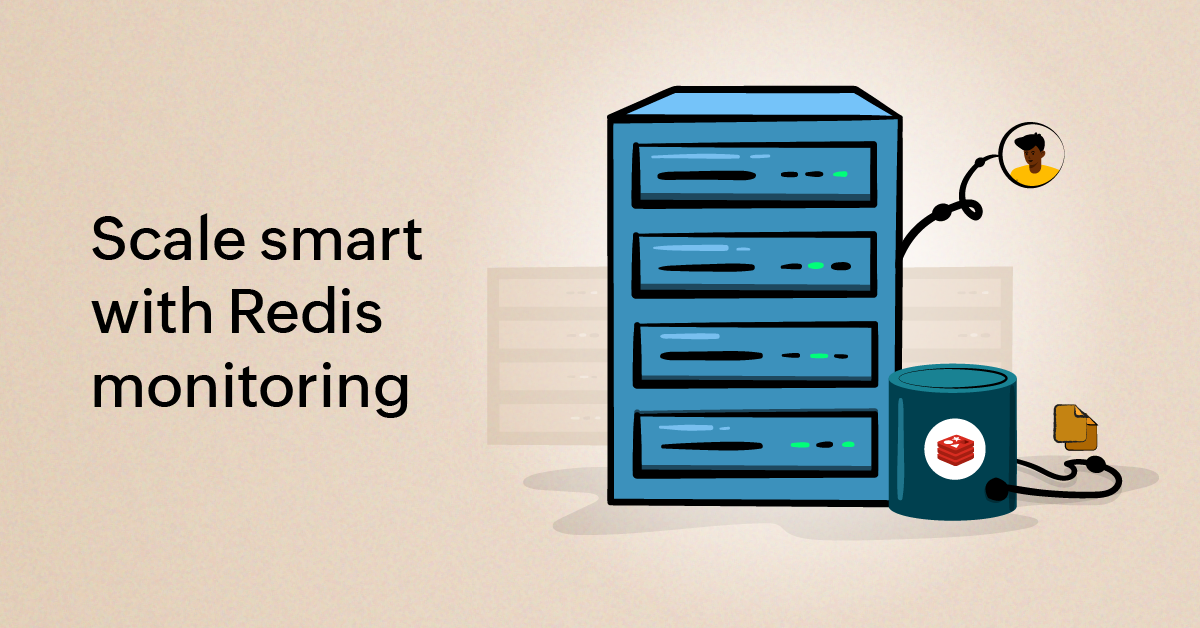The role of Redis monitoring in scaling applications for high-traffic environments

High-traffic applications demand speed, reliability, and scalability, making Redis a top choice for tasks like caching and real-time analytics. However, as traffic grows, ensuring Redis operates at peak performance requires effective monitoring. By tracking key metrics, addressing bottlenecks, and optimizing resource use, Redis monitoring plays a vital role in maintaining stability and scalability. This blog delves into why Redis is essential, the challenges of scaling it, and how monitoring ensures smooth performance in high-demand environments.
Why Redis is critical for high-traffic applications
Redis is essential for high-traffic applications due to its speed, advanced features, and scalability.
Key features of Redis
- In-memory storage: Redis stores data in memory, enabling ultra-fast read and write operations, making it ideal for real-time use cases like leaderboards or live analytics.
- Advanced data structures: Redis supports lists, sets, hashes, and sorted sets, allowing efficient handling of complex tasks such as user session management or ranking systems.
- Scalability: Clustering and sharding distribute workloads across nodes, ensuring performance even as traffic scales.
Use cases in high-traffic scenarios
- Caching: Redis reduces the load on the database by storing frequently accessed data, such as product details or user profiles, enabling faster retrieval and improved system performance.
- Real-time analytics: Redis tracks and aggregates data to support live dashboards or perform trend analysis, allowing businesses to make quick, data-driven decisions.
- Session and queue management: Redis manages user sessions and task queues using atomic operations, ensuring reliability and consistency—even during periods of high traffic.
Redis's ability to handle these tasks efficiently makes it a cornerstone in scaling applications for demanding traffic scenarios.
Challenges in scaling Redis for enterprises with high-traffic applications
Scaling Redis for high-traffic applications comes with key challenges that require careful planning.
Performance bottlenecks
- Latency issues: High traffic can increase command processing times, impacting real-time applications like live messaging or bidding.
- Overloaded nodes: Uneven traffic distribution in clusters can overwhelm certain nodes, leading to degraded performance or failures.
Memory management
Eviction policies: Redis uses eviction policies like least recently used (LRU) or least frequently used (LFU) when memory limits are reached. Poorly configured policies may lead to the loss of critical data, such as active sessions or cache entries.
Fault tolerance
High availability: Node failures can disrupt services if replication and failover mechanisms aren’t properly set up, risking data loss or downtime during traffic surges.
By addressing these challenges with optimized configurations and proactive monitoring, Redis can handle high traffic efficiently.
The importance of Redis monitoring
Redis monitoring plays a vital role in maintaining performance and reliability in high-traffic environments. By keeping an eye on key metrics, it ensures smooth operations and optimal resource utilization.
Preventive maintenance
Proactive monitoring allows teams to identify and address performance bottlenecks before they impact end users. For example, tracking latency spikes, command execution times, or queue backlogs can reveal underlying issues early. This approach minimizes disruptions during traffic surges, ensuring consistent application performance.
Optimizing resource utilization
Redis is an in-memory database, making efficient resource usage crucial. Monitoring metrics such as memory consumption, CPU usage, and active connections ensures optimal performance. For instance, detecting excessive memory usage can help fine-tune eviction policies, while tracking CPU load prevents overloads during peak traffic.
Supporting horizontal and vertical scaling
As applications grow, Redis must scale to handle increasing traffic. Monitoring ensures smooth horizontal scaling (adding nodes) and vertical scaling (upgrading resources). By tracking node health, shard distribution, and replication lag, teams can avoid scaling-related bottlenecks and maintain high availability.
Key metrics to monitor in Redis for high traffic environments
Monitoring the right metrics in Redis ensures optimal performance, efficient resource utilization, and reliability. Here’s a breakdown of the most critical metrics to track.
Performance metrics
- Latency: Measures the time it takes for Redis to process a command. High latency indicates potential bottlenecks in operations.
- Command processing time: Tracks how long Redis takes to execute commands, helping identify slow queries or heavy operations.
- Throughput: Indicates the number of commands processed per second, reflecting Redis's capacity to handle high traffic.
Resource utilization
- Memory usage: Monitoring memory consumption ensures that Redis stays within limits and avoids out-of-memory errors.
- Fragmentation ratio: Identifies inefficient memory allocation, which could lead to wastage and impact performance.
- Keyspace hits and misses: Shows cache efficiency by tracking the ratio of successful lookups (hits) versus unsuccessful lookups (misses).
Persistence and replication
- RDB and AOF status: Tracks the status of Redis Database (RDB) snapshotting and append-only file (AOF) persistence methods to ensure data durability.
- Replication lag: Measures the delay between the primary and replica nodes, critical for ensuring real-time data consistency.
- Sync performance: Monitors the time taken for replicas to synchronize with the primary node, which can affect failover reliability.
Connection management
- Active connections: Monitors the number of current client connections to ensure Redis is handling traffic as expected.
- Rejected connections: Tracks connection requests denied due to resource constraints, indicating potential capacity issues.
By monitoring these metrics, teams can maintain Redis's performance and scalability, ensuring a seamless user experience—even in high-traffic environments.
Ensure Redis success with proactive monitoring
Scaling high-traffic applications with Redis requires not only its speed and versatility but also effective monitoring to ensure optimal performance. Proactive tracking of key metrics like latency, memory usage, and replication is essential to avoid bottlenecks and ensure seamless scaling. With Site24x7's Redis monitoring, you gain real-time insights, intelligent alerts, and in-depth analytics to keep Redis running smoothly. Whether you're scaling a growing app or managing enterprise workloads, Site24x7 ensures Redis remains reliable and efficient in demanding environments. Sign up today!
Topic Participants
Sinjan Ballav